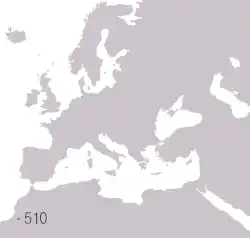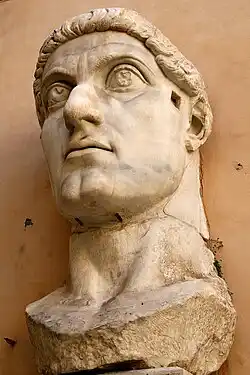
The fall of the Roman Empire, also called the fall of the Western Roman Empire or the fall of Rome, was one of the most significant events in all of human history. It led to the collapse of the Mediterranean cultures of the Greeks, Romans, and others which had reached levels of cultural and social sophistication by the second century CE that had never been seen before and would not be seen again until the eighteenth century in Europe. It also marked the shift from one of the four or five major epochs of human history to another, specifically the movement from ancient history to medieval history. The reasons for the fall of the empire have consequently been widely discussed and there are a few key elements to the central theses in this respect, notably the political crisis of the imperial system, an economic crisis brought about by rampant inflation, and most importantly, the incursion of millions of Germanic and Asiatic tribespeople from northern Europe and the Asian Steppe into the lands of the empire from the third century CE onwards. Eventually, these overran the Western Roman Empire and led to its complete destruction in the fifth century. In the process, they also transformed the demographic, ethnic, and cultural environment of much of Europe and parts of North Africa too.[1]
Chronology of eventsChronology of events
Unlike in modern times, when superpowers generally tend to come and go in a matter of decades, in ancient times some states lasted as major powers for centuries or even millennia in the case of Pharaonic Egypt. A good example of this is Rome. The state gradually emerged from the amalgamation of several small villages dotted on several hills along the banks of the River Tiber from the tenth century BCE onwards. By the fifth century BCE it had become a republic and entered into a period of substantial expansion which saw it conquer much of central and southern Italy by the early third century BCE. After that, it expanded rampantly, with parts of Spain and North Africa conquered in the late third century BCE, then Greece and parts of the Eastern Mediterranean in the second century BCE and finally much of the Levant, Turkey, the Balkans, Gaul (analogous to modern-day France and the Low Countries) and parts of western Germania in the first century BCE. By the time the empire was created under Caesar Augustus in 27 BCE the empire extended from Portugal in the west to northern Iraq in the east, and from the Saharan Desert in the south to the North Sea in the north. Though some new areas were conquered in the centuries that followed, Rome generally focused on consolidating its holdings thereafter and securing its border.[2]

For a time all was bliss. It is generally agreed that the empire was at its most prosperous in the second century CE under the so-called ‘Five Good Emperors’. But very soon after this problems began. Civil wars became rampant from the 230s CE onwards as dozens of contenders to become emperor arose, the economy entered a period of immense turmoil as inflation became rampant and new foreign invaders such as the Franks, Alemanni, Goths, and Sarmatians showed up on the northern borders between Germania and the Black Sea. These began raiding into the empire, often taking control of broad swathes of territory for years or decades.[3]
Eventually, the Crisis of the Third Century, as it is known, abated as political order was restored under rulers like Diocletian and Constantine the Great. However, the problem posed by newcomers to Rome’s borders never abated. Instead, it got worse in the second half of the fourth century and into the fifth century as new people like the Ostrogoths, Visigoths, Franks, Burgundians, Huns, and Vandals made incursions into Rome’s borders. While the eastern provinces would survive under the control of a Greek emperor ruling from Constantinople (modern-day Istanbul), in the end the western provinces were completely overrun, and in 476 CE the last Western Roman Emperor, Romulus Augustulus, was deposed, the terminal date of the Roman Empire in the west.[1]
Extent of migrationExtent of migration
It is difficult to assess the extent of the migration involved to any reasonably accurate extent, as there were no censuses or demographic records being carried out on these newcomers with which to determine their numbers. However, some speculative points can be made. For instance, the Huns, who for a time in the first half of the fifth century CE under their warlord, Atilla the Hun, controlled an empire stretching from Austria and Hungary eastwards to the shores of the Black Sea, must have been comprised of hundreds of thousands of individuals who had migrated westwards from the Asian Steppe since as early as the second or third centuries CE.[4] Equally the Visigoths, Ostrogoths, and Franks were arriving in large enough numbers to conquer entire provinces from a Roman army which itself was comprised of hundreds of thousands of men at its height. Moreover, all of this was occurring over a period of centuries, between the middle of the third century down to the sixth century even after the Western Roman Empire came to an end. As such, while we cannot put accurate figures on it, it is reasonable to conclude that millions of Germanic and Asiatic peoples arrived in the lands of the Roman Empire, and in particular the western provinces, during this era.[5]
Demographic impactDemographic impact
The demographic impact of all of this was immense. It transformed the demographic landscape of Western Europe in particular as these newcomers settled in huge numbers in particular areas. For instance, the Franks occupied much of what is now France, while the Burgundians settled along the border between Gaul and Germania in the region we know as Burgundy today. The Visigoths settled much of Spain, with a smaller group, the Suebi, colonizing much of northern Portugal and north-western Spain. Finally, the Ostrogoths conquered mainland Italy, but were soon replaced by a new group in the north of the country called the Lombards, whose dominance there is reflected in the geographical term for the region, the Plain of Lombardy, today. Other seafaring groups such as the Angles and the Saxons headed across the North Sea and conquered England.[6]
These groups did not come to entirely dominate these regions ethnically. Instead over time, they married with the Romans and Gallic or Iberian groups who had lived there in ancient times, forming during the medieval period the concepts of being French, Spanish, etc. These changes also brought great cultural and social changes. For instance, each of these people developed their own dialects of Latin which were combinations of Latin and their own Germanic dialects. Over time these became the Romance languages, French, Italian, Spanish, and Portuguese, along with others such as Occitan which are less well-known today. They also brought new elements of Germanic culture to bear on the Latin cultures they discovered in the newly conquered regions. Thus, over time a hybrid culture of Germanic and Roman elements developed here in medieval times as a result of the fall of the Roman Empire.[7]
See alsoSee also
Explore more about Fall of the Roman EmpireExplore more about Fall of the Roman Empire
- European record collection at MHeritage
- Italian record collection at MHeritage
- He Was the 1st Olympic Champion in 1,500 Years… and No One Cared on the MyHeritage blog
- Shaping Europe: 5 important events on the MyHeritage blog
References
- ↑ 1.0 1.1 Fall of the Western Roman Empire. World History Encyclopedia
- ↑ Ancient Rome. History Channel
- ↑ The Crisis of the Third Century. World History
- ↑ Huns. History Channel
- ↑ Barbarian Movements. School of Divinity, University of Edinburgh
- ↑ The Break-up of Mediterranean Unity. Historia Siglo XX
- ↑ Material culture. Encyclopedia Britannica

